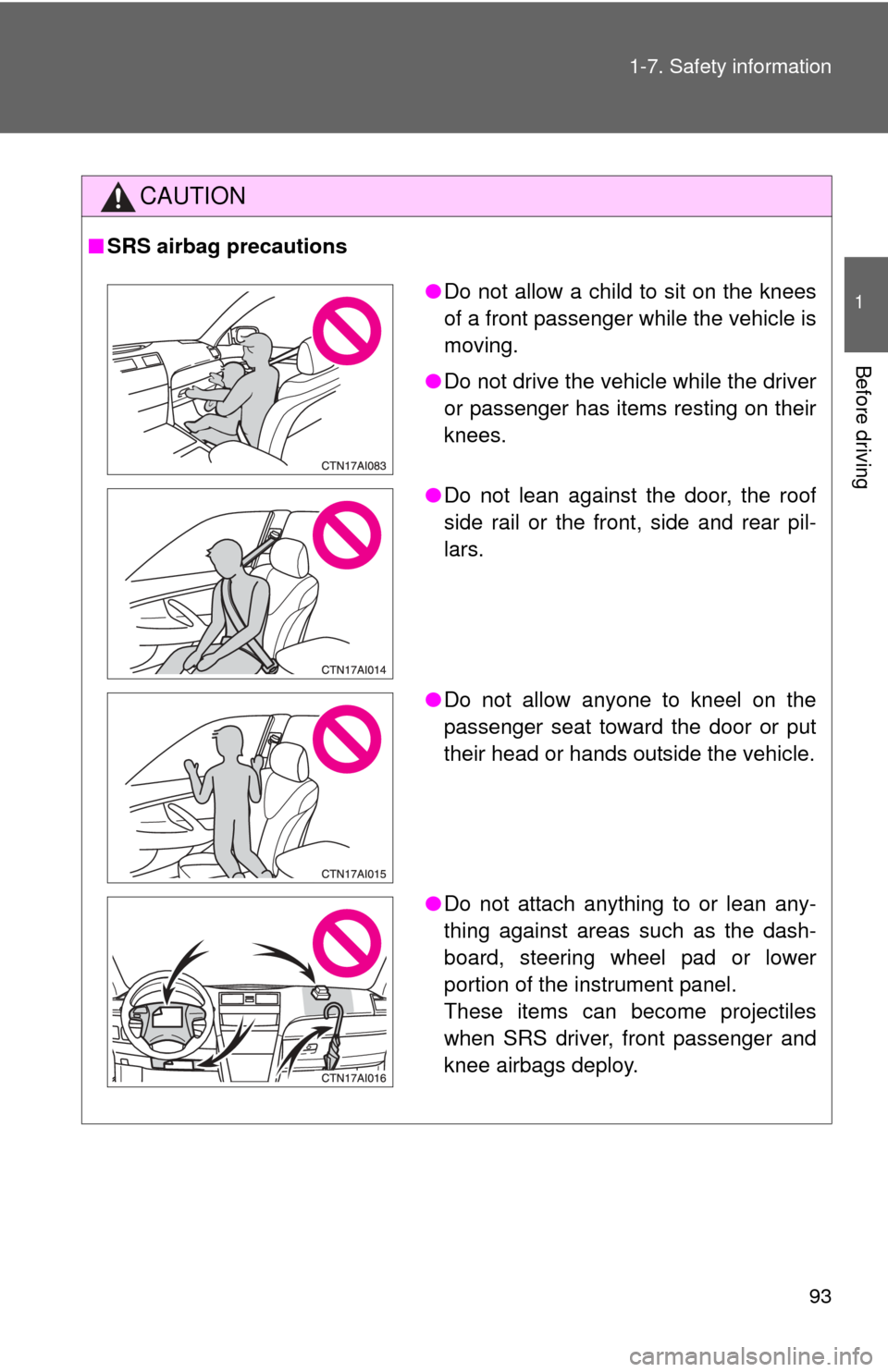2008 TOYOTA CAMRY tow
[x] Cancel search: towPage 1 of 476

TABLE OF CONTENTS
1
1Before drivingAdjusting and operating features such as door locks,
mirrors, and steering column.
2When drivingDriving, stopping and safe-driving information.
3Interior fea-
turesAir conditioning and audio systems, as well as other in-
terior features for a comfortable driving experience.
4Maintenance
and careCleaning and protecting your vehicle, performing do-it-
yourself maintenance, and maintenance information.
5When trouble
arisesWhat to do if the vehicle needs to be towed, gets a flat
tire, or is involved in an accident.
6Vehicle
specificationsDetailed vehicle information.
7For U.S. own-
ersReporting safety defects for U.S. owners
IndexAlphabetical listing of information contained in this
manual.
Page 3 of 476

1
2
3
4
5
6
7
3
2-3. Operating the lights and wipers .............................. 152
Headlight switch .................. 152
Fog light switch ................... 156
Windshield wipers and washer .............................. 157
2-4. Using other driving systems ........................... 159
Cruise control ...................... 159
Driving assist systems ........ 162
2-5. Driving information ........... 165 Cargo and luggage ............. 165
Vehicle load limits ............... 168
Winter driving tips ............... 169
Trailer towing ...................... 173
Dinghy towing (automatic
transmission) .................... 181
Dinghy towing (manual transmission) ...... 182
3-1. Using the air conditioning system and defogger...... 186
Automatic air conditioning system .............................. 186
Manual air conditioning system .............................. 194
Rear window and outside rear view mirror defoggers ....... 199 3-2. Using the audio system ... 201
Audio system types ............ 201
Using the radio ................... 204
Using the CD player ........... 210
Playing MP3 and WMA discs ....................... 217
Optimal use of the audio system .............................. 225
Using the AUX adapter....... 228
Using the steering wheel audio switches.................. 229
3-3. Using the hands-free phone system
(for cellular phone)......... 232
Hands-free phone system (for cellular phone) features
(CD player with changer
only) ................................. 232
Using the hands-free phone system
(for cellular phone) ........... 235
Making a phone call ........... 244
Setting a cellular phone ...... 248
Security and system setup ................................ 253
Using the phone book ........ 257
3-4. Using the interior lights ... 264 Interior lights list ................. 264
• Interior light ...................... 265
• Personal lights.................. 266
3Interior features
Page 5 of 476

1
2
3
4
5
6
7
5
5-1. Essential information ....... 374If your vehicle needs to be towed ........................... 374
If you think something is wrong ............................ 377
Fuel pump shut off system .............................. 378
Event data recorder ............ 379
5-2. Steps to take in an emergency ....................... 381
If a warning light turns on or a warning buzzer
sounds... ......................... 381
If a warning message is displayed (vehicles with
multi-information
display) ............................. 391
If you have a flat tire............ 400
If the engine will not start .... 411
If the shift lever cannot be shifted from P (automatic
transmission) .................... 413
If you lose your keys ........... 414
If the electronic key does not operate properly
(vehicles with smart key
system) ............................. 415
If the battery is discharged ........................ 417
If your vehicle overheats ..... 421
If the vehicle becomes stuck ................................. 424 6-1. Specifications ................... 428
Maintenance data (fuel, oil level, etc.) ........... 428
Fuel information.................. 439
Tire information .................. 442
6-2. Customization................... 454 Customizable features........ 454
6-3. Initialization....................... 458 Items to initialize ................. 458
Reporting safety defects for U.S. owners ................ 460
Abbreviation list ........................ 462
Alphabetical index .................... 463
What to do if... ......................... 473
5When trouble arises6Vehicle specifications
7For U.S. owners
Index
Page 30 of 476

30 1-2. Opening, closing and locking the doors and trunk
■Operation signals
A buzzer sounds and the emergency flashers flash to indicate that the doors
have been locked/unlocked. (Locked: Once; Unlocked: Twice)
■ Conditions affecting operation
The smart key system uses weak radio waves. In the following situations,
the communication between the electronic key and the vehicle may be
affected, preventing the smart key system and wireless remote control from
operating properly. (Ways of coping: P. 415)
● When the electronic key battery is depleted
● Near a TV tower, electric power plant, gas station, radio station, large dis-
play, airport or other facility that generates strong radio waves or electri-
cal noise
● When carrying a portable radio, ce llular phone, cordless phone or other
wireless communication devices
● When the electronic key has come into contact with, or is covered by, a
metallic object
● When multiple electronic keys are in the vicinity
● When carrying or using the electronic key together with the following
devices that emit radio waves
• Another vehicle’s electronic key
• A wireless key that emits radio waves
• Personal computer
● If window tint with a metallic content or metallic objects are attached to
the rear window
Page 39 of 476

39
1-2. Opening, closing and locking the doors and trunk
1
Before driving
■
Security feature
If a door is not opened within approximately 60 seconds after the vehicle is
unlocked, the security feature automatically locks the vehicle again.
■ When the electronic key battery is fully depleted (vehicles with smart
key system)
P. 353
■ Conditions affecting operation
Vehicles with smart key system
P. 3 0 Vehicles without smart key system
The wireless remote control function may not operate normally in the follow-
ing situations.
● Near a TV tower, radio station, electr ic power plant, airport or other facil-
ity that generates strong radio waves
● When carrying a portable radio, cell ular phone or other wireless commu-
nication devices
● When multiple wireless keys are in the vicinity
● When the wireless key has come into contact with, or is covered by, a
metallic object
● When a wireless key (that emits radio waves) is being used nearby
● When the wireless key has been left near an electrical appliance such as
a personal computer
Page 53 of 476

53
1
1-3. Adjustable components (seats, mirrors, steering wheel)
Before driving
Head restraints
■Adjusting the height of the head restraints
■ Adjusting the rear cent er seat head restraint
Always raise the head restraint one level from the stowed position when
using.
Vertical adjustment
Push and hold the lock release
button when lowering the head
restraint.
Removal
Pull the head restraint up while
pressing the lock release but-
ton.
Lock
release
button
Make sure that the head restraints are
adjusted so that the center of the head
restraint is closest to the top of your ears.
Page 91 of 476

91
1-7. Safety information
1
Before driving
CAUTION
■
SRS airbag precautions
Observe the following precautions regarding the airbags.
Failure to do so may cause death or serious injury.
●The driver and all passengers in the vehicle must wear their seat belts
properly.
The SRS airbags are supplemental devices to be used with the seat belts.
● The SRS driver airbag deploys with considerable force, and can cause
death or serious injury especially if the driver is very close to the airbag.
The National Highway Traffic Safety Administration (“NHTSA”) advises:
Since the risk zone for the driver’s airbag is the first 2 - 3 in. (50 - 75 mm)
of inflation, placing yourself 10 in. (250 mm) from your driver airbag pro-
vides you with a clear margin of safety. This distance is measured from the
center of the steering wheel to your breastbone. If you sit less than 10 in.
(250 mm) away now, you can change your driving position in several
ways:
• Move your seat to the rear as far as you can while still reaching the pedals comfortably.
• Slightly recline the back of the seat. Although vehicle designs vary, many drivers can achieve the 10 in.
(250 mm) distance, even with the driver seat all the way forward, sim-
ply by reclining the back of the seat somewhat. If reclining the back of
your seat makes it hard to see the road, raise yourself by using a firm,
non-slippery cushion, or raise the seat if your vehicle has that feature\
.
• If your steering wheel is adjustable, tilt it downward. This points the air- bag toward your chest instead of your head and neck.
The seat should be adjusted as recommended by NHTSA above, while
still maintaining control of the foot pedals, steering wheel, and your view of
the instrument panel controls.
Page 93 of 476

93
1-7. Safety information
1
Before driving
CAUTION
■
SRS airbag precautions
●Do not allow a child to sit on the knees
of a front passenger while the vehicle is
moving.
● Do not drive the vehicle while the driver
or passenger has items resting on their
knees.
● Do not lean against the door, the roof
side rail or the front, side and rear pil-
lars.
● Do not allow anyone to kneel on the
passenger seat toward the door or put
their head or hands outside the vehicle.
● Do not attach anything to or lean any-
thing against areas such as the dash-
board, steering wheel pad or lower
portion of the instrument panel.
These items can become projectiles
when SRS driver, front passenger and
knee airbags deploy.